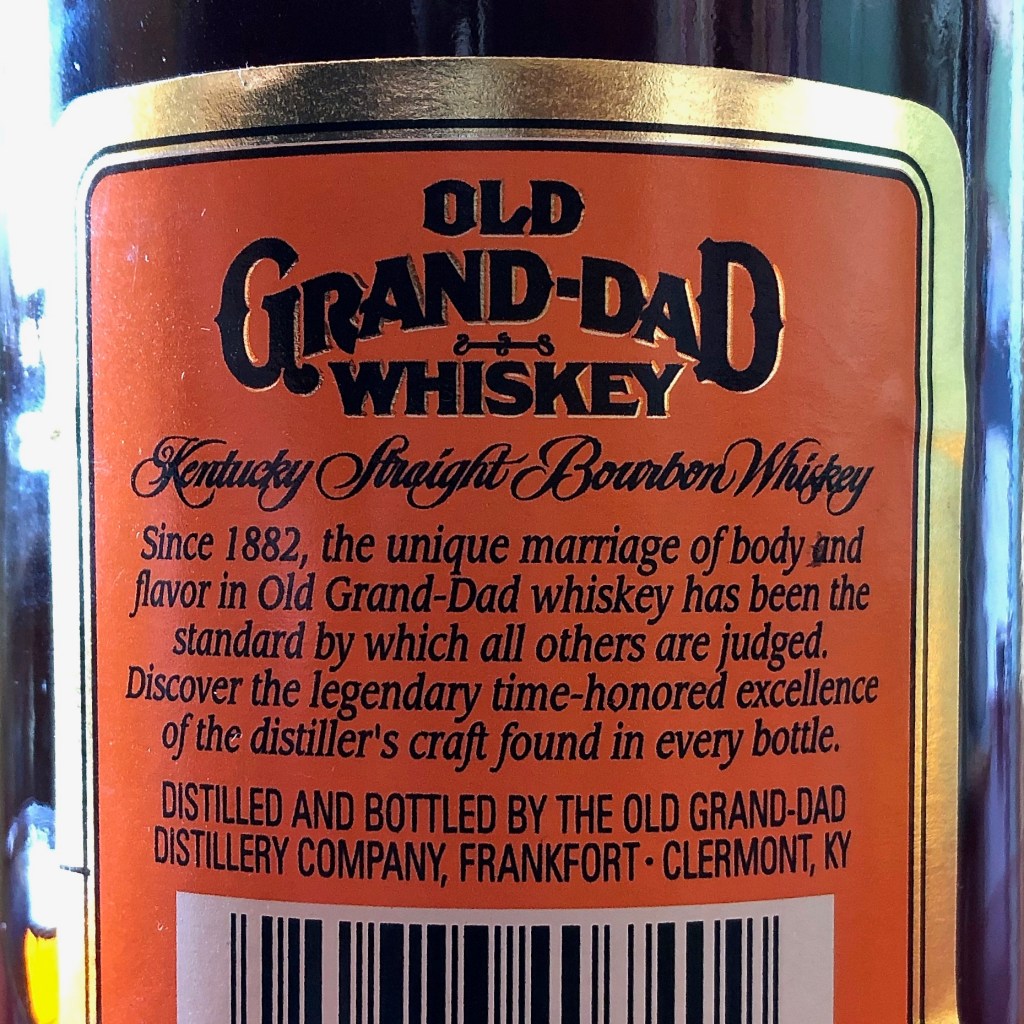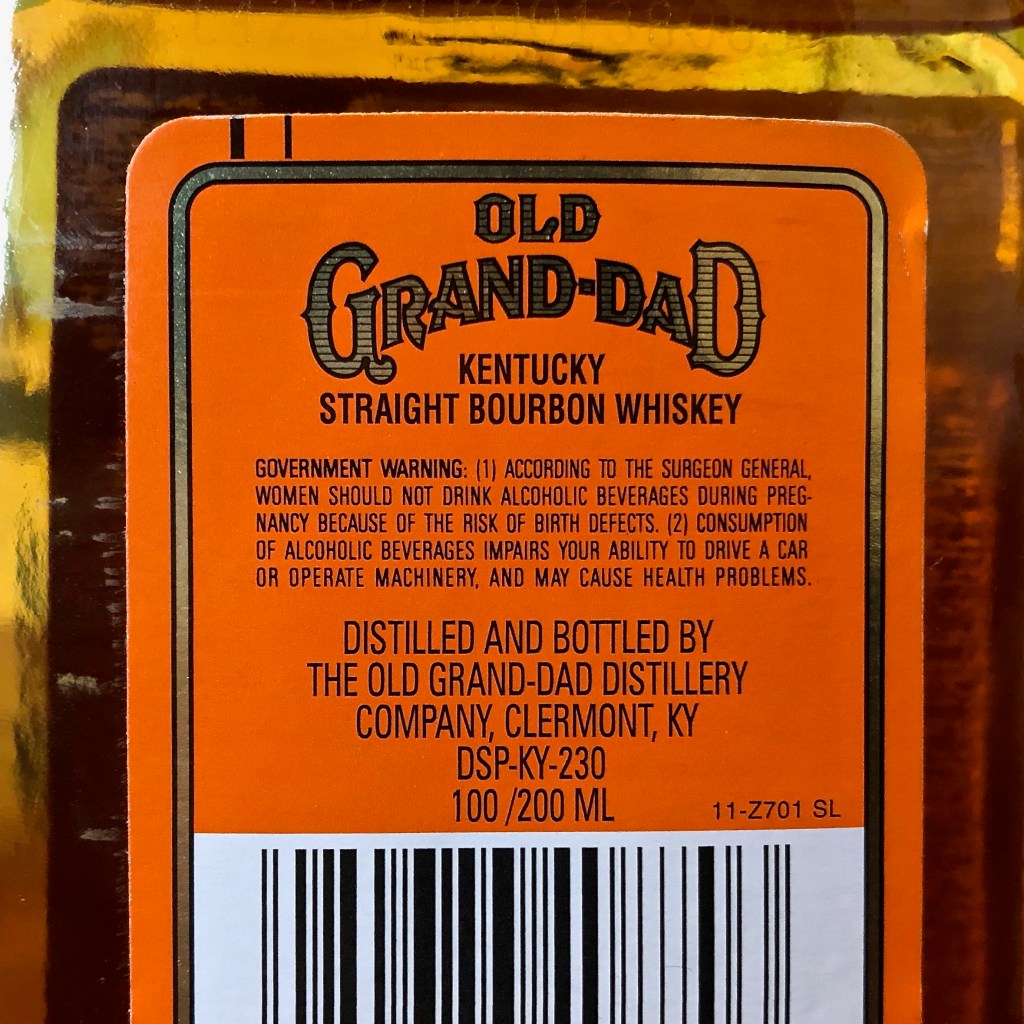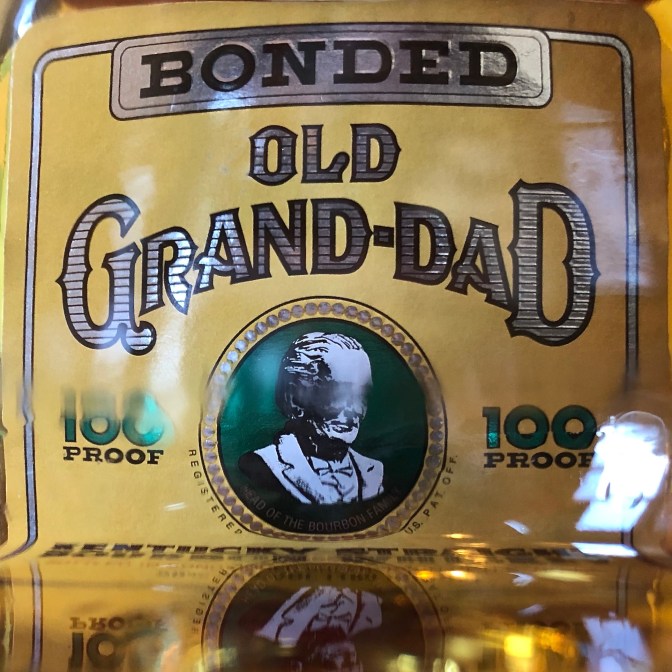OLD GRAND DAD 86
Bottled in 1997MASH BILL – 63% corn, 27% rye, 10% barley
PROOF – 86
AGE – NAS
DISTILLERY – Jim Beam
PRICE – $40 from an acquaintance
BUY AGAIN? – Sadly, no…
Old Grand Dad was an early favorite when I started my bourbon journey. I liked the 100-proof bottled-in-bond edition as a friendly, lively, basic bourbon. Even better, the 114-proof version brought more oomph to the table, pushing the bourbon’s fruit notes forward from its high-rye mash bill.
And so it was with great enthusiasm that I recently came into this 1997 bottling of the 86-proof edition—discontinued in 2013 and replaced by an 80-proof edition.
Usually I taste bourbons in a standard 5-ounce brandy glass. But this is an old Old Grand Dad. I poured the first shot into a good ol’ fashioned, nondescript tumbler. Seemed more appropriate. You want to hear the glass hit the table when you’re drinking old grandpa’s whiskey!
Here are the notes in brief:
COLOR – a classic bright bourbon orange
NOSE – vanilla, dusty rye spice, coarsely crushed cinnamon, light caramel
TASTE – corny sweetness, fruity caramel, a thin but creamy texture, a bitter/tannic edge on swallowing
FINISH – a lingering peppery tingle, the corn sweetness fading gently but fairly quickly
OVERALL – an old school, cheap, workhorse bourbon
Upon uncorking, the nose is the most complex aspect. Very inviting, actually. The palate is then suddenly much simpler by comparison, missing the intrigue that comes from the nose’s rye and cinnamon aspects. Then the finish is unremarkable. Overall the bourbon is fine, neither attention grabbing nor off-putting. That bitter/tannic edge is actually less bothersome here, to my memory, than in the 100-proof. And this 86-proof naturally lacks the flavorful punch of the 114. One might guess the 100 meets the 86 and 114 in the middle to achieve the finest balance. But it’s my impression that “fine balance” is not really a goal with any version of Old Grand Dad. It’s a bourbon workhorse meant for cocktails first and perhaps very casual sipping second—neither demanding, disturbing, nor memorable.
Unlike a dusty bottle of Wild Turkey 101, the bottling date of this dusty Old Grand Dad 86 does not mean better things. I’d have to try it next to the current Old Grand Dad 80 or 100 to get a sense of any difference. Off the cuff, it tastes comparable.
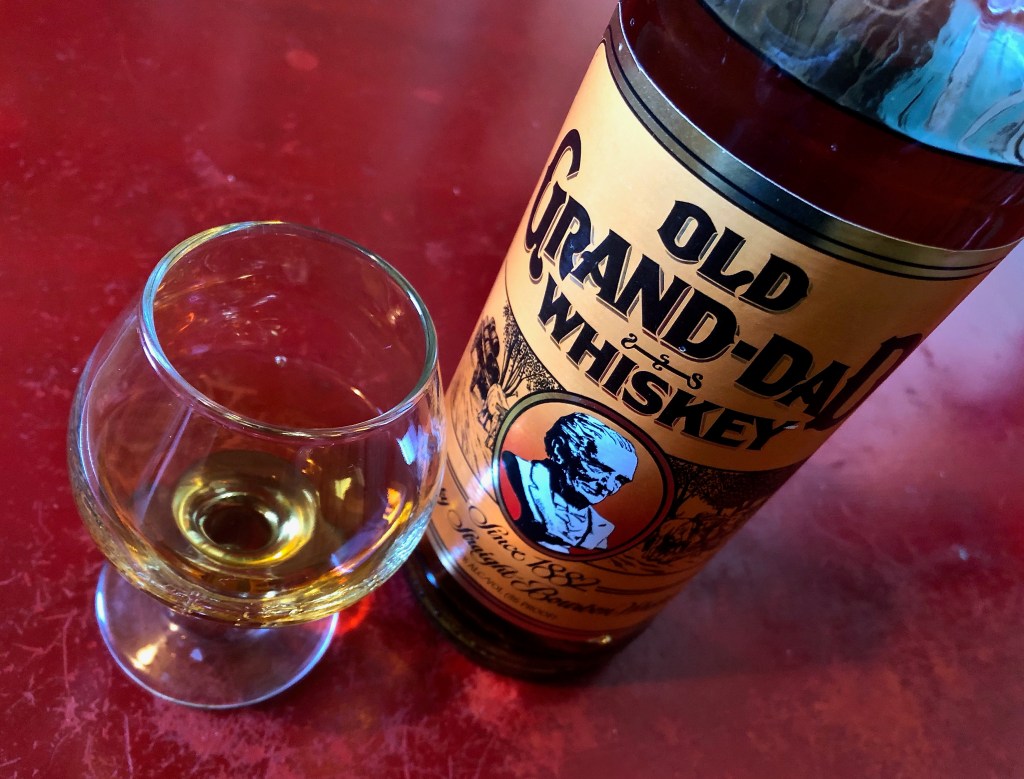
Interestingly, after making a first and then second go of it in a standard tumbler, I tried a third taste in a 5-ounce brandy glass. The nose was notably a notch more inviting. Likewise, the palate was richer in its various flavors. The finish then was as unremarkable as in the tumbler. But considering the nose and taste, the brandy glass pulled some improvement out of the whiskey at least.
After this tasting I switched over to a Glencairn of the Writers’ Tears Double Oak, an Irish whisky I’ve written up before.

Upon nosing, it immediately struck me as Old Grand Dad’s livelier Irish brother. There is a similar old-school simplicity to the aromas, minus the autumnal roughness of Old Grand Dad’s spice rack. The taste and finish both then followed suit—simple, old fashioned, and a more buoyant personality than the American gramps. On the finish, where Old Grand Dad is bitter/tannic at the edges, Writers’ Tears has a kind of plastic synthetic edge—something I’ve come to associate with whiskies with artificial coloring added, though I cannot know if that’s the cause…
The key factor in the seeming familial likeness here may not be generational—1997 versus 2019—or even American bourbon versus Irish whisky. There is something else at work. A populist intent of the makers? To manufacture something inexpensive and broadly appealing? To what extent might intent impact taste?
I wanted to try this 86-proof against a 2019 bottle of the 100-proof. But I didn’t want to buy a whole bottle, so I went looking for a 200ml bottle. There is a corner store near me where I bought one a year or two ago. I went there and they were out of stock. After more looking around, one shop keeper told me the 200ml bottles had actually been discontinued years ago and if I’d found any recently I was lucky. I put the word out to a San Francisco Bay Area whiskey Facebook group I follow, and someone had in fact recently picked a 200ml bottle up at a random liquor store in San Jose. He graciously offered to pass it on to me.

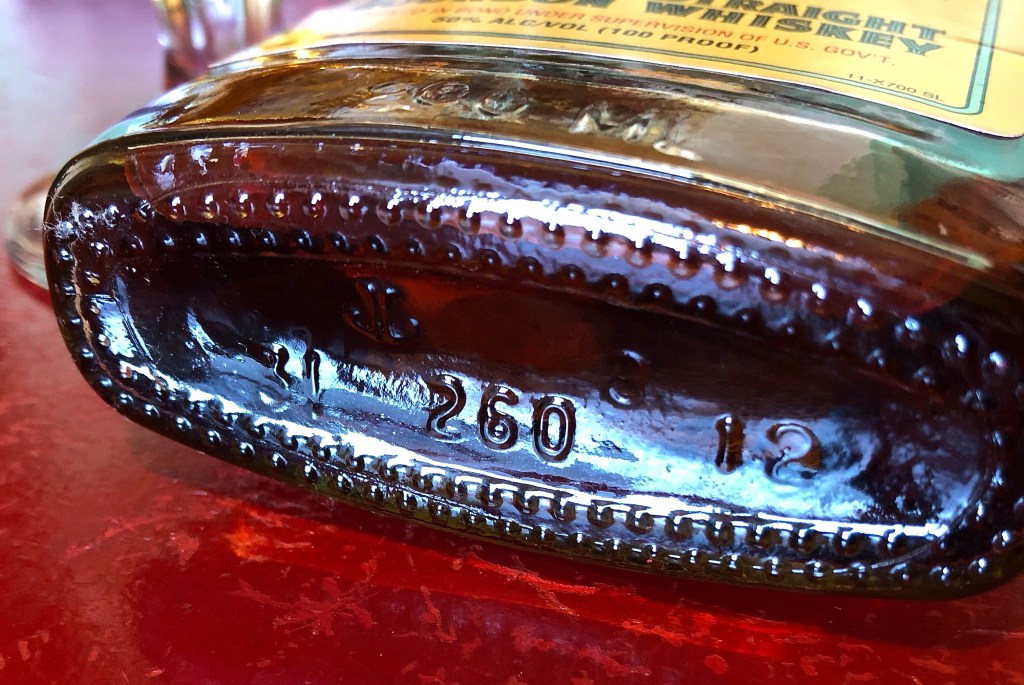
Turns out it’s a bottle from 2012—fifteen years after the 1997 bottle, but one year prior to the 86-proof’s discontinuation. So, still made within the 86-proof’s era. The front label of this 200ml bottle is notably faded as compared to its back label, still that bright OGD orange. The bottle likely spent a good many years in the sunlight, gathering dust on the San Jose shop’s window-facing shelf. Light does unfortunate things to whiskey over time, so I wondered how my comparison would go…
A week after the 1997 86-proof bottle’s uncorking, and now in brandy glasses, the comparison went like this:
COLOR
86 PROOF – a vibrant burnt orange leaving legs dripping down the glass
100 PROOF – a vibrant toasted yellow-range with thinner legs than the 86
NOSE86 PROOF – sweet tannic oak, tangy nectarine preserves, flecks of brown sugar
100 PROOF – stewy nectarine preserves not yet jarred, with cheap sugars, thin sweet caramel, peanut shell
TASTE86 PROOF – cheap bitter tannins, non-descript generic sugars and cheap caramel flavored candies
100 PROOF – cheap bitter tannins, a prickly peppery burn, fake caramel
FINISH86 PROOF – warm, tannic, short
100 PROOF – tannic, plastic, cheap caramels
OVERALL86 PROOF – the embodiment of old-school cheap bourbon
100 PROOF – an argument for Old Grand Dad’s retirement

Well. Neither was enjoyable. Both conjured images in my head of Toys ‘R’ Us or The Dollar Store, big sterile warehouses filled with colorful plastic trash in the guise of gaudy toys and unnecessary knickknacks.
The 86-proof was far less appealing now than at its uncorking, and even then “appealing” would have been a description to debate. At its uncorking it was more neither-here-nor-there. With a week’s air it has become distinctly synthetic. The sun-bleached 2012 100-proof had a similarly artificial sense about it overall. Whether that is a result of the era it was bottled, the effects of sunlight, or merely the DNA of this bottom-shelf stalwart, I can’t know for certain. (We know it’s not caramel coloring, as with the Irish Writers’ Tears, since additives are not allowed in bourbon.) The 2012 100-proof’s similarity to the 1997 86-proof suggests Old Grand Dad’s DNA may indeed be the explanation.
For a proper and thorough study I’d need to get a bottle each of the 2019 80-proof, 100-proof, the 114-proof. But nothing about these 1997 and 2012 bottles inspires me to revisit their contemporary counterparts. My nostalgia has been thoroughly quelled. Earlier in my bourbon journey, Old Grand Dad was a rock-solid step in the crooked path leading through the gateway to my whiskey journey. I can only surmise that, innumerable whiskeys later, my sensitivity to flavors has broadened and deepened and therefore the congenially crotchety facade of Old Grand Dad no longer out charms the bargain-basement flavors inside. It’s a bit like reconnecting to a relative you haven’t seen since you were much younger, when you found them entertaining in their eccentricities, and now years later you realize they’re merely human—flawed as humans are, and mediocre.
Assuming the intent behind Old Grand Dad is indeed to manufacture something inexpensive, that mission has been accomplished and going strong for years. If the intent is also to manufacture something broadly appealing from a taste standpoint, I’m surprised Old Grand Dad is still around at all. And if, actually, it exists to satisfy the need for ultra-inexpensive bourbons desired by customers whose sole intent is to get drunk, then I’d think the 200ml bottles would still be produced. That Old Grand Dad is now released only in 750ml and 1-leter bottles suggests it’s intended as a base bourbon for bartenders to dilute in cocktails. But there are similarly priced bourbons that can achieve that and much more—Wild Turkey 101, Larceny, or Rebel Yell 100, to name a few.
And so, sadly, I am compelled to say: ‘Night Grand Dad, I’ll miss my memory of you.

Epilogue:
To snap a few more photos, I filled another tumbler with some 86-proof. Photos taken, I took one last clinging-goodbye sip. And this time it was better in the tumbler than in the brandy glass! Opposite from the uncorking!
So, maybe it’s not the glass, but rather that one must simply have had a handful of shots already for Old Grand Dad to regain his charms?
Interesting. But still not great.



